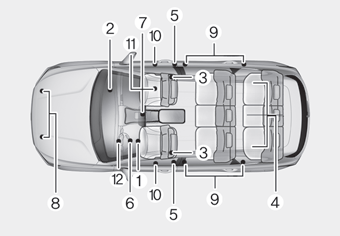Hyundai Palisade: ESP(Electronic Stability Program) System / Steering Angle Sensor
Hyundai Palisade (LX2) 2020-2025 Service Manual / Brake System / ESP(Electronic Stability Program) System / Steering Angle Sensor
Description and operation
| Description |
The Steering Angle Sensor (SAS) is installed in MDPS (Motor Driven Power Steering)
and it sends messages to HECU through CAN communication line.
The SAS is used to determine turning direction and speed of the steering wheel.
The HECU uses the signals from the SAS when performing ESC-related calculations.
Components (Steering Angle Sensor, Torque Sensor, Failsafe relay, etc.) of the
EPS system are located inside the steering column & EPS unit assembly and the
steering column.
|
 Downhill Brake Control Switch
Downhill Brake Control Switch
Description and operation
Description
The DBC function is the acronym word of Downhill Brake Control function. When
a vehicle goes down the hill, just pushing the DBC switch enables the car to
keep its vehicle's speed at a constant value without operating the brake pedal...
Other information:
Hyundai Palisade (LX2) 2020-2025 Owner's Manual: Power liftgate opening height user setting
Follow the instructions below to set the fully open height of the power liftgate: 1. Position the liftgate manually to the height you prefer. 2. Press the power liftgate inner button for more than 3 seconds. 3. Close the liftgate manually after hearing the buzzer sound...
Hyundai Palisade (LX2) 2020-2025 Service Manual: Description and operation
Description Exhaust emissions (CO, HC, NOx) are controlled by a combination of engine modifications and the addition of special control components. Modifications to the combustion chamber, intake manifold, camshaft and ignition system form the basic control system...
Categories
- Manuals Home
- 1st Generation Palisade Owners Manual
- 1st Generation Palisade Service Manual
- Theft-alarm system
- AWD Operation
- Check Tire Pressure
- New on site
- Most important about car
How Does the Air Bag System Operate?

The SRS consists of the following components:
1. Driver's front air bag module
2. Passenger's front air bag module
3. Side air bag modules
4. Curtain air bag modules
5. Retractor pre-tensioner
6. Air bag warning light
7. SRS control module (SRSCM)/
Rollover sensor
8. Front impact sensors
9. Side impact sensors
10.Side pressure sensors
11. Occupant classification system
12. Driver’s knee airbag module
Copyright © 2025 www.hpalisadelx.com


